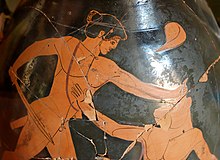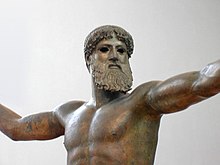History
Soúnio has been a sacred site since very ancient times. The "sanctuary of Sounion" is first mentioned in the Odyssey, as the place where Menelaus stopped during his return from Troy to bury his helmsman, Phrontes Onetorides.Archaeological evidence has shown that there were two organized places of worship on the cape by the 7th century BC: a sanctuary of Poseidon at the southern edge and a sanctuary of Athena about 500 m to the northeast.
Construction on a grand Temple of Poseidon began around 500 BC but was never completed; the temple and all the votive offerings were destroyed by the Persians in 480 BC. The Temple of Poseidon that now stands at Soúnio was built in 444 BC atop the older temple ruins. The Temple of Athena was also built at this time, atop her ancient sanctuary on the cape.
The sanctuaries began to decline from the 1st century BC onwards. Pausanias, who sailed along the coast around 150 AD, wrongly believed the prominent temple on the hill was the Temple of Athena.
Modern travellers visited Sounion long before excavations started on the site, including Lord Byron in 1810. Systematic excavations began on the site in 1897 and continue today.
What to See
Local marble was used for the Temple of Poseidon's Doric columns; 15 of the original 34 survive today. The columns were cut with only 16 flutings instead of the usual 20, which reduced the surface area exposed to the wind and sea water.On the east side of the main path is an Ionic frieze made from 13 slabs of Parian marble. Badly eroded now, it depicted scenes from the battle of the Lapiths and centaurs and from the adventures of the hero Theseus (son of Poseidon in some legends).
The east pediment, on which only a seated female figure is preserved, probably once depicted the battle between Poseidon and Athena for the domination of Attica.
Lord Byron carved his name in the marble of one of the columns in 1810. He set an unfortunate precedent, as the temple is now covered in scrawled signatures and initials.
Legend
Theseus slays the Minotaur. Detail from Attic red-figure pelike. ca. 470 BC. From Cerveteri, Italy. Museo Gregoriano Etrusco
Bronze statue of deity, prob. Zeus, about to hurl (missing) bolt. Height: 2.1 m. ca. 460 B.C. Found in shipwreck off Cape Artemisium. Athens National Archaeological Museum.
The earliest literary reference to Sounion is in Homer 's poem the Odyssey, probably composed in the 8th century B.C. This recounts the mythical tribulations suffered by Greek hero Odysseus in a gruelling 10-year sea-voyage to return to his native island, Ithaca in the Ionian sea, from the sack of Troy. This ordeal was supposedly inflicted upon him by Poseidon, to whom the temple at Sounion was dedicated.
We are told that, as the various Greek commanders sailed back from Troy, the helmsman of King Menelaos of Sparta 's ship died at his post while rounding "holy Sounion, cape of Athens". Menelaos landed at Sounion to give his companion full funeral honours (i.e. cremation on a funeral pyre on the beach). [2] The Greek ships were then caught by a storm off Cape Malea and scattered in all directions.
History
Archaeological finds on the site date from as early as 700 B.C. Herodotus tells us that in the sixth century B.C., the Athenians celebrated a quadrennial festival at Sounion, which involved Athens' leaders sailing to the cape in a sacred boat.[3]The original, Archaic Period temple of Poseidon on the site, which was built of tufa, was probably destroyed in 480 B.C. by Persian troops during shahanshah Xerxes I 's invasion of Greece (the second Greco-Persian War). Although there is no direct evidence for Sounion, Xerxes certainly had the temple of Athena, and everything else, on the Acropolis of Athens razed as punishment for the Athenians' defiance.[4] After they defeated Xerxes in the naval Battle of Salamis, the Athenians placed an entire enemy trireme (warship with three banks of oars) at Sounion as a trophy dedicated to Poseidon.[5]
The later temple at Sounion, whose columns still stand today, was probably built in ca. 440 B.C. This was during the ascendancy of Athenian statesman Pericles, who also rebuilt the Parthenon in Athens.
In 413 B.C., during the Peloponnesian War against the Spartans, the Athenians fortified the site with a wall and towers, to prevent it from falling into Spartan hands. This would have threatened Athens' seaborne grain supply route from Euboea. Athens' supply situation had become critical, since the city's land supply - lines had been cut by the Spartan fortification of Deceleia, in north Attica.[6] However, not long after, the Sounion fortress was seized from the Athenians by a force of rebel slaves from the nearby silver mines of Laurium.[7]
Temple of Poseidon
Ancient Greek religion was essentially propitiatory in nature: i.e., based on the notion that to avoid misfortune, one must constantly seek the favour of the relevant gods by prayers, gifts and sacrifices. To the ancient Greek, every natural feature, e.g. hill, lake, stream or wood, was controlled by a god. Thus a person about to swim in a river, for example, would say a prayer to the river-god, or make an offering to that god's shrine, to avoid the chance of drowning. The gods were considered immortal, could change shape, become invisible and travel anywhere instantaneously. But in many other respects they were considered similar to humans. They shared the whole range of human emotions, both positive and negative. Thus, in their attitudes towards humans, they could be both benevolent and malicious. As humans also, they had family and clan hierarchies. They could even mate with humans, and produce demi-gods.[8]In a maritime country like Greece, the god of the sea was bound to occupy a high position in the divine hierarchy. In power, Poseidon was considered second only to Zeus (Jupiter), the supreme god himself. His implacable wrath, manifested in the form of storms, was greatly feared by all mariners. In an age without mechanical power, storms very frequently resulted in shipwrecks and drownings.
The temple at Sounion, therefore, was a venue where mariners, and also entire cities or states, could propitiate Poseidon, by making animal sacrifice, or leaving gifts.
The temple of Poseidon was constructed in approx. 440 B.C., over the ruins of a temple dating from the Archaic Period. It is perched above the sea at a height of almost 60 m. The design of the temple is a typical hexastyle i.e. it had a front portico with 6 columns.[9] Only some columns of the Sounion temple stand today, but intact it would have closely resembled the contemporary and well-preserved Temple of Hephaestus beneath the Acropolis, which may have been designed by the same architect.
As with all Greek temples, the Poseidon building was rectangular, with a colonnade on all four sides. The total number of original columns was 42: 18 columns still stand today. The columns are of the Doric Order. They were made of locally-quarried white marble. They were 6.10 m (20 ft) high, with a diameter of 1 m (3.1 ft) at the base and 79cm (31 inches) at the top.[10]
At the centre of the temple colonnade would have been the hall of worship (naos), a windowless rectangular room, similar to the partly intact hall at the Temple of Hephaestus. It would have contained, at one end facing the entrance, the cult image, a colossal, ceiling - height (6m) bronze statue of Poseidon.[11] Probably gold-leafed, it may have resembled a contemporary representation of the god, appropriately found in a shipwreck, shown in the figure above. Poseidon was usually portrayed carrying a trident, the weapon he supposedly used to stir up storms.
Archaeological excavation of the site in 1906 uncovered numerous artefacts and inscriptions, most notably a marble kouros statue[12] and an impressive votive relief,[13] both now in the Athens National Archaeological Museum.[14]
Byron inscription

Lord Byron wearing Albanian costume. Portrait by Thomas Phillips
ca. 1813-
- Place me on Sunium's marbled steep,
- Where nothing, save the waves and I,
- May hear our mutual murmurs sweep...
Quick Facts
| Site Information | |
| Names: | Temple of Poseidon at Soúnio; Sanctuary of Poseidon at Soúnio |
| Location: | Soúnio, Attica, Greece |
| Faith: | Ancient Greek |
| Dedication: | Poseidon |
| Category: | Greek Temples |
| Architecture: | Greek |
| Date: | 444 BC |
| Size: | Temple floor area: 13.47 x 31.12 m |
| Status: | ruins |
| Photo gallery: | Temple of Poseidon at Soúnio Photo Gallery |
| Visitor Information | |
| Address: | Soúnio (5.5 miles S of Lavrio), Attica, Greece |
| Coordinates: | 37.64993° N, 24.024818° E (view on Google Maps) |
| Lodging: | View hotels near this location |
| Phone: | 22920 39363 |
| Website: | odysseus.culture.gr |
| Opening hours: | Apr 10-Oct 31: 8:30am-8pm Closed March 25 |
| Cost: | Full: €4, Reduced: €2 |
| Parking: | Parking is available at the site. |












